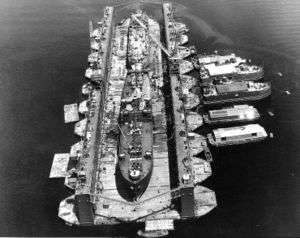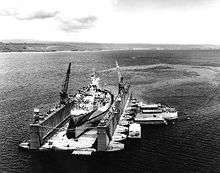USS Artisan (ABSD-1)
 Artisan (ABSD-1) with USS Antelope (IX-109) and LST-120 in the dock at Espiritu Santo, New Hebrides Islands, 8 January 1945 | |
| History | |
|---|---|
| Laid down: | 1942 and 1943 |
| Commissioned: | 10 May 1943 |
| Decommissioned: | 1 March 1987 |
| Reclassified: |
|
| Struck: | 1 March 1987 |
| Reinstated: | March 1987 |
| Honors and awards: |
|
| Fate: |
|
| Status: | Section B laid up at NISMF, Pearl Harbor, 1 March 1987 |
| General characteristics | |
| Displacement: | 38,500 (in ten sections) |
| Length: | 927 ft (283 m) (in ten sections) |
| Beam: | 256 ft 0 in (78.03 m) |
| Height: | 9 ft (2.7 m) floated, 78 ft (24 m) flooded |
| Capacity: | 90,000 tons lift |
| Complement: | 690 officers and men |
| Armament: | none |
USS Artisan (ABSD-1), later redesignated as (AFDB-1), a ten-section, non-self-propelled, large auxiliary floating drydock, was the only ship of the United States Navy given this name. She was constructed in sections during 1942 and 1943 by the Everett Shipbuilding Company, in Everett, Washington; the Chicago Bridge & Iron Company, in Eureka, California; the Pollock-Stockton Shipbuilding Company, in Stockton, California; and the Chicago Bridge & Iron Company, in Morgan City, Louisiana. Her official commissioning ceremony took place at Everett, Washington, on 10 May 1943, Captain Andrew R. Mack in command.
War service
The floating drydock made the voyage to the southwestern Pacific in two separate convoys. The two sections constructed on the Gulf Coast departed Morgan City, Louisiana, on 14 July 1943, while the remaining eight sections concentrated at San Francisco, California, before putting to sea on 28 August 1943. The first two sections arrived at Espiritu Santo in the New Hebrides on 24 September, and the West Coast sections reached that destination on 2 October. Later that month, the drydock's crew began assembly procedures. On 2 November in the course of assembling the drydock, one of its sections sank, drowning 13 of her crew. By the end of 1943, she was a working drydock of eight sections repairing a variety of Navy ships at Espiritu Santo. In April 1944, ABSD-1 became a full ten-section drydock when her remaining section was combined with another from ABSD-2 and was joined to the eight already functioning. With all ten sections joined, she was 927 feet long, 28 feet tall (keel to welldeck), and with an inside clear width of 133 feet 7 inches.
She served in the New Hebrides until mid-April 1945 at which time she received orders to disassemble and move forward to the big base at Leyte Gulf in the Philippines. ABSD-1 completed disassembly by the beginning of June and, on 30 June, the first six sections began the voyage, via Hollandia, New Guinea, to Leyte. The remaining four sections took departure on 7 July. The first echelon arrived at Manicani Bay, Samar Island, on 27 July, and assembly began three days later. On 2 August, the rest of the drydock entered Manicani Bay and, by mid-September, all ten sections had been joined together. The floating drydock resumed her repair work soon thereafter, and it continued through February 1946. On 28 February 1946, she undocked four yard craft and began preparations for inactivation. ABSD-1 was decommissioned on 31 May 1946.
Post-war service
She remained in the Philippines through the summer and fall of 1946. During that time, in August 1946, the advanced base sectional dock was reclassified a large auxiliary floating drydock and was redesignated AFDB-1. Sometime after November 1946, her sections were towed from the Philippines to Pearl Harbor where they were placed in reserve. Her inactivity lasted almost exactly five years. She was recommissioned at Pearl Harbor on 2 June 1951, Captain O. J. Stien, USNR, in command. Later that month, she was towed, in sections, to Guam in the Mariana Islands where the Navy was improving another repair facility in fairly close proximity to the combat zone in the year-old Korean War. Reporting for duty on 26 June 1951, she was not completely assembled and ready for duty until the beginning of March 1952.
Active at Apra Harbor not quite three years, AFBD-1 was out of commission again and back in reserve by January 1955. She remained inactive at Guam for a little more than 15 years. In 1970, five of her sections were moved to Subic Bay in the Philippines where the floating drydock was placed in service once again on 17 November 1970. Her third period of active service proved to be her longest lasting almost 16 years. On 7 June 1979, she was named Artisan. In October 1986, Artisan was placed out of service, and her name was struck from the Naval Vessel Register. In March 1987, however, Artisan received a reprieve when her name was reinstated on the Naval Vessel Register.
On 16 August 1996 her Section 1D was reclassified as unclassified miscellaneous vessel IX-521, and on 2 March 1998 her Section 1C was reclassified to IX-525.
Image gallery
 Columbia (CL-56) docked in Artisan ABSD-1
Columbia (CL-56) docked in Artisan ABSD-1 Columbia docked upon Artisan
Columbia docked upon Artisan AFDB-1 with West Virginia (BB-48) high and dry in the dock
AFDB-1 with West Virginia (BB-48) high and dry in the dock
References
This article incorporates text from the public domain Dictionary of American Naval Fighting Ships. The entry can be found here.
External links
| Wikimedia Commons has media related to USS Artisan (AFDB-1). |
- Photo gallery of USS Artisan (ABSD-1) at NavSource Naval History: Artisan AFDB-1, ABSD-1, IX-521 / IX-525
- This article includes information collected from the Naval Vessel Register, which, as a U.S. government publication, is in the public domain. The entries can be found here and here.
- This article includes information collected from the Naval Vessel Register, which, as a U.S. government publication, is in the public domain. The entries can be found here and here.
- This article includes information collected from the Naval Vessel Register, which, as a U.S. government publication, is in the public domain. The entries can be found here and here.